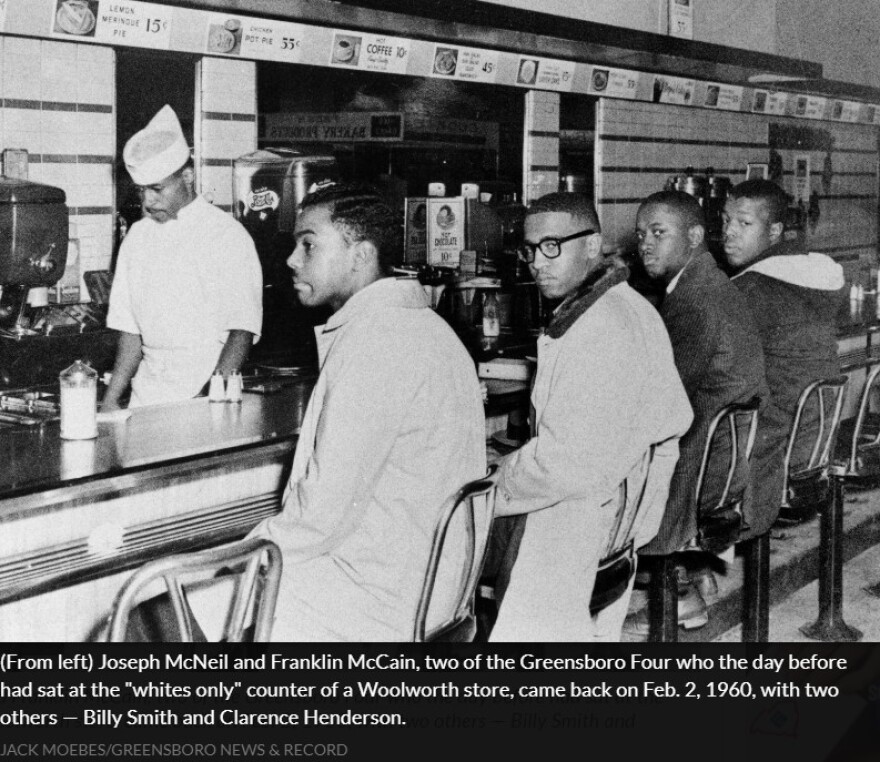Feb. 1 marks the start of Black History Month, but it’s also the 60th anniversary of the sit-in of four African American students from North Carolina A&T State University at a segregated Woolworth’s lunch counter in Greensboro.
The students, Joseph McNeil, Franklin McCain, Ezell Blair and David Richmond were known as the Greensboro Four. They were not the first to stage sit-ins like this but as they courageously showed up at the Woolworth’s for nearly six months, word of their actions spread across the nation, sparking youths, especially in college towns to push for change. The Student Non-Violent Coordinating Committee, SNCC, formed in Raleigh at Shaw University shortly after the Greensboro sit-ins started.
Today, the Greensboro Woolworth is the home of the International Civil Rights Center and Museum. WBTV reporter Steve Crump was there for its opening and has now produced a documentary on one of the Greensboro Four -- McCain -- who lived in Charlotte. In this interview, WFAE "All Things Considered" host Gwendolyn Glenn talks to Crump about the documentary and why he chose to focus on McCain.

Steve Crump: Some of this is a bit of a rehash and with the focus being on Franklin McCain and considering that I’ve interviewed him a lot over the years and there was a lot of material that ended up on the cutting floor, so we resurrected that. The following week after the Greensboro sit-ins, students at Johnson C. Smith University, led by the late Charles Jones, jumped into the action, as well.
Gwendolyn Glenn: Why did you choose to focus on McCain, alone? Most documentaries focus on all four.
Crump: Frank, as I call him, lived in Charlotte. We were good friends and a lot of people viewed him as the architect of what happened in Greensboro. And he had a great story.
Glenn: Tell me more about him.
Crump: Frank was a businessman, worked for Celanese with a degree in chemistry. He was a loved father and grandfather, and in spite of where he was in this amazing contribution to history, he was a regular guy.
Glenn: Here’s what McCain said, taken from the documentary on how he felt on the historical Greensboro sit-in.
“I had a sense of dignity, a sense of worth and manhood to an extent I had never felt in my life before," he said. "It was overwhelming and I had the real feeling that if life ended at that very moment, I would not have been cheated at all."
Crump: Frank did not give up after the lunch counters were desegregated in Greensboro. He found himself at the March on Washington and along with his wife, a graduate of Bennett College — the women from Bennett participated with the North Carolina A&T students as well — they championed for many years the NAACP Legal Defense Fund headed by [the late U. S. Supreme Court Justice] Thurgood Marshall for many years and later fell on the shoulders of Julius Chambers, Charlotte civil rights attorney.
The other thing about Franklin, in terms of the gravity of what he had done: I was at the Newseum and his picture was there, but at the new African American Museum, I was in the cafeteria there and what do I see on the wall? A mural of Frank McCain and the Greensboro Four. And there were artifacts of things that came out of Greensboro as part of a tribute.

Glenn: The Woolworth is now the International Civil Rights Museum.
Crump: And it is a riveting and compelling museum. Not only do you have the lunch counter and separate water fountains, but they’ve done an excellent job of recreating the past.
Glenn: I love how they have all of the artifacts from the lunch counter -- plates, everything -- and the visuals behind the counter and video makes you think you are there.
Crump: Yes. In interviewing Franklin McCain, he describes the museum being his conscience. He says he feels a moral obligation as a result of what that museum stands for and represents. Franklin passed away in 2014 and I was honored to be one of his pallbearers and at that funeral at Friendship Missionary Baptist Church, there were a lot of speakers, including the Rev. Jesse Jackson.
Crump’s documentary “Franklin McCain: Flashbacks and Observations of a Civil Rights Trailblazer” will be shown at a free screening on Feb. 5 at the Harvey B. Gantt Center for African American Arts and Culture. It will air on Feb. 21 on WBTV and Feb. 22 on Bounce TV.


